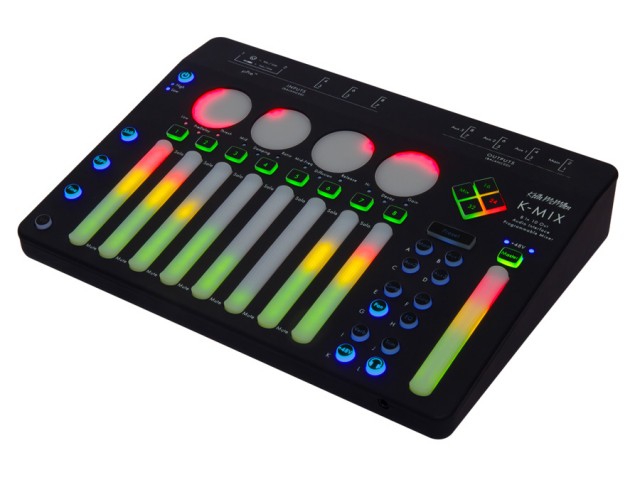
Here’s an in-depth look at using the Keith McMillen K-Mix Programmable Mixer:
The K-Mix is ‘not your grandma’s mixer’, according to KMI. It has no moving parts, so it can be used as a portable mixer, without the fear of snapping off a fader or knob, while still giving you top audio quality, mixer functionality and control.
The K-Mix looks different than other mixers, because KMI founder Keith McMillen wanted a mixer that was different than the mixers that were available. “I needed a very special mixer that did not exist,” explains McMillen, “a fully-programmable, MIDI-controlled, ultra-high-quality portable mixer.”
“Not having a mixer that could do all of this, when wanting to play live in a group without a sound man, was heartbreaking,” adds McMillen. “K-MIX had to be capable of tying all of my needs together — from live inputs to USB interfaces — to then operate as a fully-programmable stage mixer.”
Pricing and Availability
K-MIX carries an MSRP of US $599.99 and is available to purchase from any authorized Keith McMillen Instruments dealer or directly from the Keith McMillen Instruments site. Technical details are also available at the KMI site.

Cool, cool, but maybe someone can help me out – I haven’t heard the obvious question answered… What’s the deal with the rubbery faders/knobs? I get that they are meant to double as pressure-sensitive controls on stuff like the quNEO, but having to push IN while tweaking a line fader seems like… something I would rather not do. And in the video, the demonstrator’s finger seems to stutter/snag in a few places when moving slowly. That is a problem when doing things like recording automation, something that should be at the top of the list for mixer usability. Are these controls pressure-sensitive too? I don’t see it mentioned, and if not, why not just make them smooth capacitative touch-faders?
Good question! I have never tried rubber faders myself, but can imagine that perhaps they’d work well with some lubricant?
The controls are not pressure sensitive, and you don’t have to apply much (any) pressure to get them to respond. The faders and rotaries send location data only.
I’ve heard good things about the product range yet by God these control surfaces are hideous!
man, if this thing had adat I’d be all over it plugged into my apollo.
As mentioned in another thread, I just got one of these (and I’m having some issues with audio coming out of only one headphone channel, which I suspect is a hardware fault but will wait for KMI to confirm). My first impressions? Heavier than I thought, quite nice to touch, slight learning curve for skipping between all the different modes but mostly quite manageable and something you’d probably become intimately familiar with very quickly. It’s definitely unlike any other mixer or audio interface I’ve used, and what the good and bad parts of that are, I’m sure I’ll find out soon.
The preamps do sound good, the effects are nice and the faders etc are quite nice to the touch. I worry that the screenprinted control labels will probably wear off, as the type is pretty thin to begin with, and they’re printed on the rubberised case (which I also assume will, with a bit of wear, start to wear down and/or flake/peel a bit). I had naively been hoping I could carry this in a (clean) bag with other items without wrapping, padding etc but I don’t think that’s the case.
I haven’t used other interfaces in quite the same situations/setups as the one specific and quite limited one I tested the K-Mix with today, but I did notice some potential issues with shielding, and other small noise-related things. Even if they turn out to be ongoing issues, I’ll find this mixer/interface useful. Anyway, I’ll report back, I guess. (I’m using Logic Pro X, not Live, so I suspect MIDI Learn etc will be a pinch more annoying than for others!)